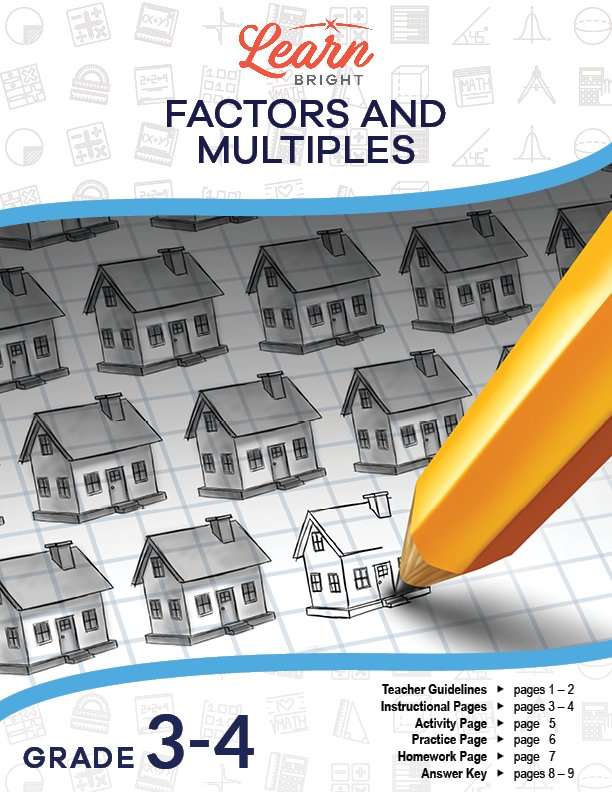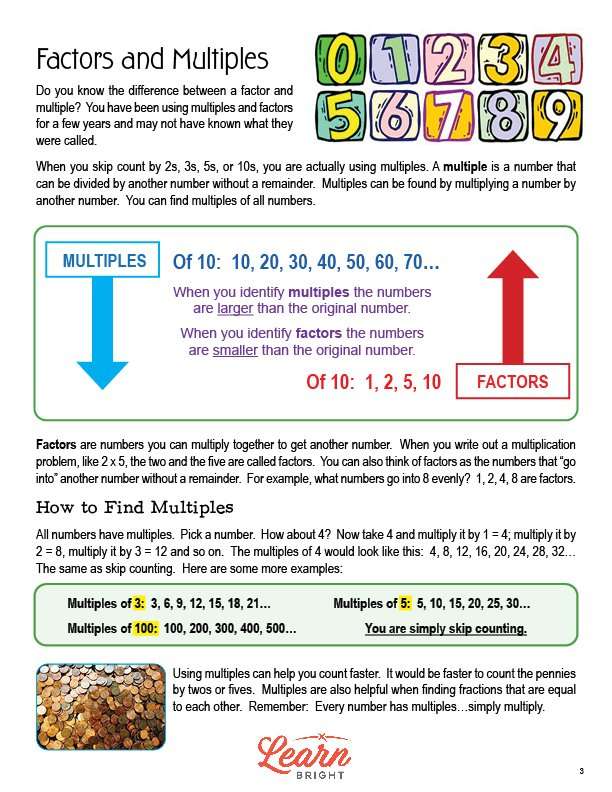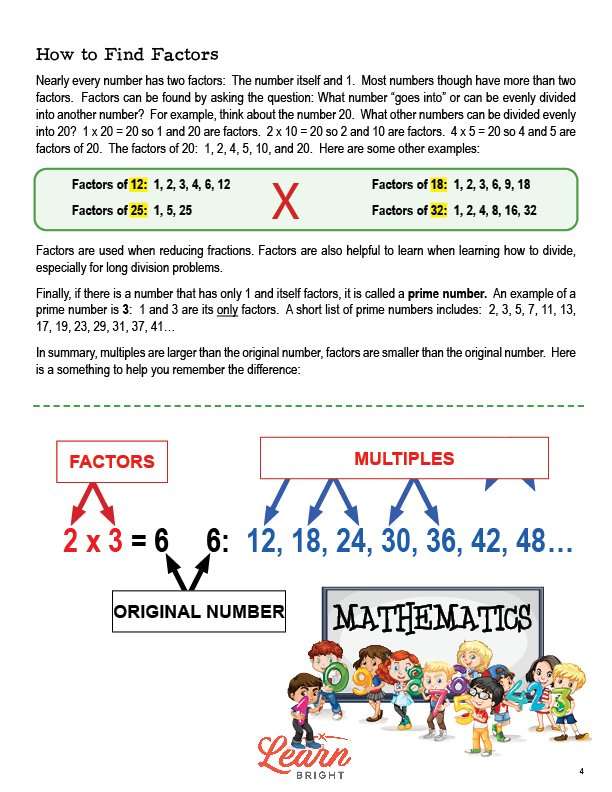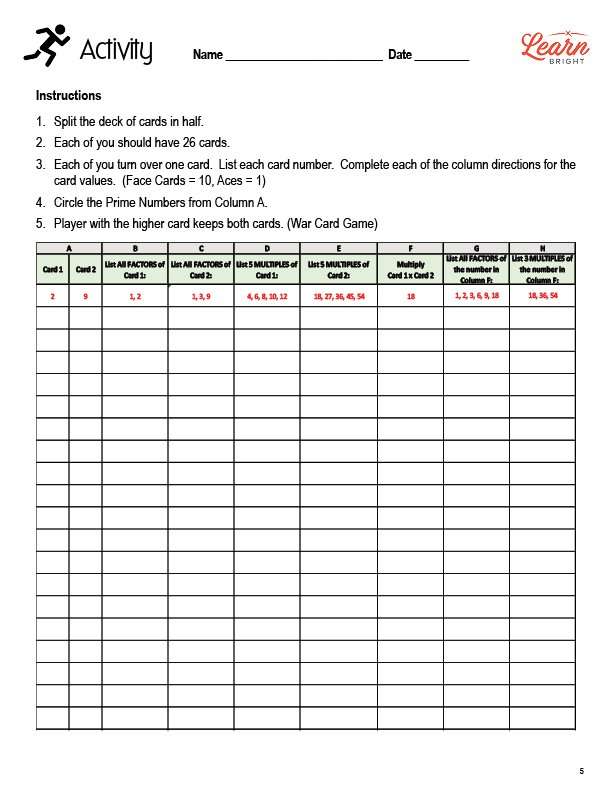Description
What our Factors and Multiples lesson plan includes
Lesson Objectives and Overview: Factors and Multiples defines factor and multiple and enables students to identify the factors and multiples of whole numbers. At the end of the lesson, students will be able to define factor and multiple. The students will be able to find the factors and multiples of whole numbers. This lesson is for students in 3rd grade and 4th grade.
Classroom Procedure
Every lesson plan provides you with a classroom procedure page that outlines a step-by-step guide to follow. You do not have to follow the guide exactly. The guide helps you organize the lesson and details when to hand out worksheets. It also lists information in the blue box that you might find useful. You will find the lesson objectives, state standards, and number of class sessions the lesson should take to complete in this area. In addition, it describes the supplies you will need as well as what and how you need to prepare beforehand.
Options for Lesson
Included with this lesson is an “Options for Lesson” section that lists a number of suggestions for activities to add to the lesson or substitutions for the ones already in the lesson. One optional adjustment the lesson activity is to use other cards numbers from 1 to 10 or higher instead of playing cards. You could use this lesson as an introduction to lowest common multiples and greatest common factors when introducing fractions and reducing. You could also let your students use calculators throughout the lesson.
Teacher Notes
The teacher notes page includes a paragraph with additional guidelines and things to think about as you begin to plan your lesson. This page also includes lines that you can use to add your own notes as you’re preparing for this lesson.
FACTORS AND MULTIPLES LESSON PLAN CONTENT PAGES
Factors and Multiples
The Factors and Multiples lesson plan includes two content pages. Students might not realize that they’ve been using factors and multiples for years without knowing it! When you skip count by 2s, 3s, 5s, or 10s, you’re actually using multiples. Multiples are numbers that you can divide by another number without a remainder. We can find multiples by multiplying a number by another number. All numbers have multiples.
Multiples are always larger than the original number, which factors are always smaller. For example, some multiples of 10 are 10, 20, 30, 40, 50, 60, 70, and more, while the factors of 10 are 1, 2, 5, and 10.
Factors are numbers that you can multiply together to get another number. When you look at a multiplication problem like 2 x 5, two and five are factors. We can also think of factors as numbers that can go into another number without a remainder.
How to Find Multiples
All numbers have multiples. For example, multiples for the number 4 are 4, 8, 12, 16, 20, 24, 28, 32, and so on. This is the same as skip counting. You can find multiples of any number, from 1 to 1,000!
You can often count faster if you use multiples. You could count pennies by twos or fives instead of by ones. We can also use multiples to find equal fractions. All numbers have multiples, you simply have to multiply.
How to Find Factors
Almost all numbers have two factors, the number itself and 1. Most numbers have more than two factors. We can find factors by asking what numbers “go into” or can be evenly divided into another number. For example, we can look at the number 20. We know that 1 x 20 = 20, so 1 and 20 are factors. 2 x 10 = 20, so 2 and 10 are also factors. 4 x 5 = 20, so 4 and 5 are factors. Therefore, the factors of 20 are 1, 2, 4, 5, 10, and 20.
We use factors when reducing fractions. It’s also helpful to understand them for long division problems.
Numbers that only have 1 and itself for factors are prime numbers. For example, 3 is a prime number because 1 and 3 are its only factors. Some other prime number include 2, 5, 7, 11, 13, 17, 19, 23, 29, 31, 37, and 41.
To summarize, multiples are larger than the original number, while factors are smaller!
FACTORS AND MULTIPLES LESSON PLAN WORKSHEETS
The Factors and Multiples lesson plan includes three worksheets: an activity worksheet, a practice worksheet, and a homework assignment. You can refer to the guide on the classroom procedure page to determine when to hand out each worksheet.
CARDS ACTIVITY WORKSHEET
Students will work with a partner to complete the lesson activity. Each pair will start with half a deck of cards, or 26 cards. They will take turns turning over one card, listing each card number as they go. For each card, they will complete different tasks, like listing all the factors or listing 5 multiples. After they’ve filled in the whole worksheet, they will circle the prime numbers from their list of cards.
QUESTIONS PRACTICE WORKSHEET
The practice worksheet asks students to answer 15 questions about factors and multiples. For some questions, they will need to identify the factors or multiples of specific numbers.
FACTORS AND MULTIPLES HOMEWORK ASSIGNMENT
For the homework assignment, students will first list the factors and at least five multiples of each number listed on the worksheet. They will then circle all the prime numbers from 2-49.
Worksheet Answer Keys
This lesson plan includes answer keys for the practice worksheet and the homework assignment. If you choose to administer the lesson pages to your students via PDF, you will need to save a new file that omits these pages. Otherwise, you can simply print out the applicable pages and keep these as reference for yourself when grading assignments.










